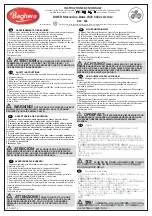
9
The only lights that work in DC are the headlights, ditch lights (when equipped) and
number boards. You can’t turn on the class lights in DC. Some throttle manufacturers
produce special doo-dads which are meant to trigger the sounds in locomotives on DC
layouts. As we have no involvement in the development of those doo-dads, we have
absolutely no idea how they will affect your SW1200, for good or for ill. As always,
we’ll try to help you fix your SW1200 if one of these doo-dads turns your locomotive’s
circuitry into something akin to burnt toast, but we can’t guarantee we’ll be able to.
It is usually at this point in the manual that Jason inserts a gentle dig at his fellow modellers
who won’t switch from DC to DCC. The rest of the staff have repeatedly reminded
him what happened the last time he did that. Something about being kidnapped by a
band of journeymen from the masons’ guild and being labelled a warlock. He still has
nightmares about it. As long as we can keep reminding him of this event, he’ll be nice
to DC modellers. However, Bobby is the one writing this manual and he thinks DC is
the easy way out. He insists everyone still operating DC is stuck in 1998 and drives a
wooden panel station wagon.
For those of you with ridged foreheads who are feeling deeply insulted, we are pleased
to inform you that Bobby has been demoted to Z Scale manual writing.
OPERATION – DCC WITH SOUND
We go to extreme lengths for accuracy, in sounds as well as in looks. Our sound decoders
are LokSound Select decoders by ESU, programmed with sounds we recorded from…
well… a GMD-1. The prime mover is the same. The hood is the similar...Kind of. The
exhaust stacks are the same. It sounds the same. So you can rest assured that the sounds
are bang-on accurate. We have upgraded the decoder to include ESU’s Full Throttle.
As we do for all of our sound decoders, we recorded the prime mover under load – it
was hauling loaded grain hoppers. Locomotives sound a lot different when they are
working. If you have decoders from other manufacturers in your locomotives you might
want to check out the available line of Rapido decoders on our web site. All of our
decoder sounds were recorded under load and we simply can’t stand decoders that
don’t have this feature.
— NOTICE —
If you want to run your sound-equipped SW1200 on a DC layout, the Back-EMF
circuit can cause issues when you’re trying to bring your M420 to a stop. To turn
off Back-EMF, you will need to bring your SW1200 to a model railroad equipped
with DCC and set CV49 to 18. If you want to turn it back on, change CV49
to 19. If you have a large DC layout and you like to operate sound-equipped
locomotives, it might be worthwhile to invest in an entry-level DCC system just
so you can adjust the motor settings of your sound-equipped fleet off the layout.




































